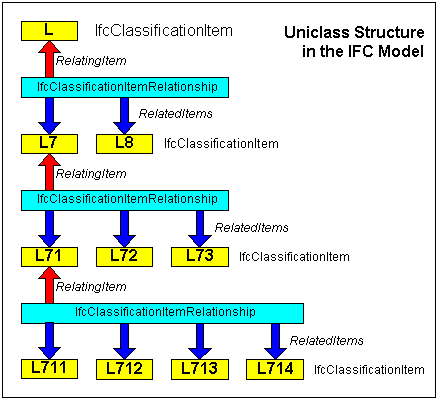
IfcClassificationItemRelationship
Definition from IAI: An IfcClassificationItemRelationship
is a relationship class that enables the hierarchical structure of a
classification system to be exposed through its ability to contain related
classification items and to be contained by a relating classification item.
HISTORY: New entity in IFC
2x.
Use Definitions
IfcClassificationItem's can be progressively decomposed using the
IfcClassificationItemRelationship such that the relationship always
captures the information about the parent level (relating) item and the child
level (related) items of which there can be many. The following example shows
how this could be achieved for the Uniclass system.

The inverse relationships from IfcClassificationItem to
IfcClassificationRelationship enable information about the relationship
to be recovered by the items concerned so that they are also aware of the
decomposition. The cardinality of the inverse relationship is that an
IfcClassificationItem can be the classifying item in only one
relationship and can be a classified item in only one relationship. This
implies that there is no overlap of IfcClassificationItem's. This
reflects typical classification approaches which use strict hierarchical
decomposition (or taxonomy) and do not have matrix relationships.
EXPRESS specification:
|
|
| ENTITY IfcClassificationItemRelationship;
|
|
Attribute definitions:
| RelatingItem
|
:
|
The parent level item in a classification structure that is used for relating the child level items.
|
| RelatedItems
|
:
|
The child level items in a classification structure that are related to the parent level item.
|
Inheritance graph
|
|
| ENTITY IfcClassificationItemRelationship;
|
|
